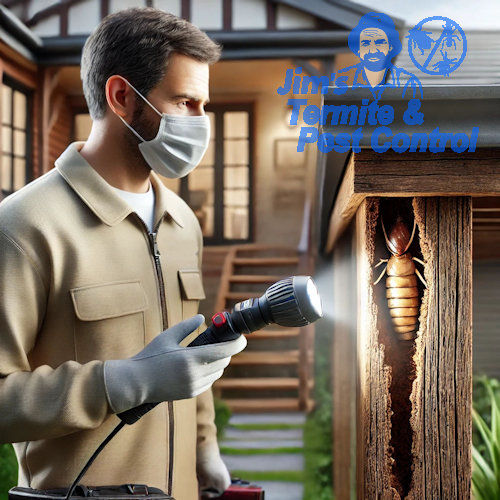Termites are a silent but destructive force, capable of causing severe damage to South Australian homes before homeowners even notice their presence, thus the need for regular termite inspections. These pests feed on wood and other materials containing cellulose, making Adelaide homes and buildings prime targets for infestations.
Unlike other pests that are more visible, termites tend to remain hidden, which is why regular termite inspections are so important. Without a proper inspection, an infestation can go undetected for years, leading to costly structural damage.
A termite inspection is a preventative measure that helps homeowners detect termites early and take action before the infestation spreads. This article explores why termite inspections are necessary, how they work, and what homeowners can expect when scheduling an inspection.
For professional and licenced termite inspection and treatment services in South Australia, in particular Adelaide and suburbs, contact Jim’s on 131 546, or complete our free pest inspection quote form.
Why Are Termite Inspections Important?
Early Detection Saves Money
One of the biggest reasons to schedule a termite inspection is to catch infestations early. The longer termites remain undetected, the more damage they cause. Over time, an untreated infestation can weaken wooden structures, compromising the integrity of the home.
Repairing termite damage can be expensive, often costing thousands of dollars. Early detection through inspections helps prevent these costly repairs.
 Protecting Your Property Value
Protecting Your Property Value
A home with a termite infestation is less appealing to buyers and may lose value. If a home is infested, potential buyers may request a price reduction or refuse to purchase the property altogether.
On the other hand, a recent termite inspection report showing no signs of infestation can increase buyer confidence. Regular inspections help ensure that termites do not threaten a home’s resale value.
Preventing Future Infestations
Even if no termites are found during an inspection, professionals can identify risk factors that might make a home vulnerable to future infestations. Inspectors assess moisture levels, cracks in foundations, and areas where wood is in contact with soil. By addressing these risks early, homeowners can reduce the chances of termites invading their property.
What Happens During a Termite Inspection?
A professional Jim’s termite inspection follows a detailed process designed to detect infestations and assess potential risks. The inspector will check various parts of the home and provide recommendations based on their findings.
Step 1: Exterior Inspection
Our inspector begins by examining the exterior of the property. This includes checking the foundation, walls, and wooden structures for signs of termites. Mud tubes, which termites build to travel between their nests and food sources, are a common indicator of infestation.
We will also look for wood damage and entry points where termites may be getting inside.
Step 2: Interior Inspection
Inside the home, the pest control technician checks walls, floors, ceilings, and wooden furniture for signs of termites. Common indicators include hollow-sounding wood, sagging floors, or peeling paint that resembles water damage. Special tools may be used to detect termites inside walls or under floors.
Step 3: Moisture Assessment
Termites thrive in damp environments. Our inspector may use moisture meters to identify areas with high humidity or leaks that could attract termites. Addressing moisture problems can help prevent infestations.
Step 4: Inspection Report and Recommendations
At the end of the inspection, the homeowner receives a detailed report outlining any findings. If termites are detected, the report will include recommendations for treatment options.
If no termites are found, the inspector may suggest preventive measures to keep the home protected.
How Often Should You Get a Termite Inspection?
The frequency of termite inspections depends on several factors, including the home’s location, age, and previous termite history.
- Annual Inspections: Experts recommend having a termite inspection at least once a year, even if no signs of termites are present.
- High-Risk Areas: Homes in warm, humid climates or areas with a history of termite activity may require inspections every six months and in some cases if it is an extremely high risk 1-3 monthly inspections are needed until risk factors have been reduced .
- Before Buying a Home: If purchasing a home, a pre-purchase termite inspection is essential to ensure the property is termite-free.
Signs That You Need a Termite Inspection
While regular inspections are recommended, homeowners should schedule an inspection immediately if they notice any of the following warning signs:
- Hollow-sounding wood: Tap on wooden surfaces—if they sound hollow, termites may have eaten the wood from the inside.
- Mud tubes: Thin tunnels made of mud on walls, foundations, or other surfaces may indicate active termites.
- Discarded wings: Termites shed their wings after finding a place to establish a new colony. Piles of wings near windows or doors are a sign of termite activity.
- Buckling or warped wood: Termites weaken wood, causing it to warp, buckle, or collapse.
- Tiny holes in wood surfaces: Small exit holes in wooden structures could be a sign of termites tunneling inside.
- If you bang on a wall and hear mud falling this can indicate that there may be termite damage within the wall.
Conclusion
A termite inspection is an essential part of home maintenance that helps detect infestations early, protect property value, and prevent future problems. Regular inspections save homeowners money by catching infestations before they cause extensive damage.
If you have never had a termite inspection or suspect you may have termites, schedule an inspection with a professional pest control service today. Preventative action is the best way to keep your home safe from these destructive pests.
Act Now!
For professional and licenced termite inspection and treatment services in South Australia, in particular Adelaide and suburbs, contact Jim’s on 131 546, or complete our free pest inspection quote form
